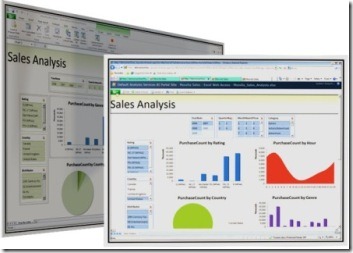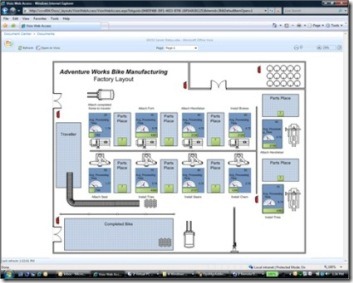SharePoint Conference 2009 Favorite Technologies Unveiled
Well it's official, the cake is baked and the conference done. so to speak. SharePoint Conference 2009 was the coming out party for SharePoint 2010 and featured some incredible content. The conference introduced the new SharePoint workloads, new features, and plenty of time to network with experts and peers. As an attendee I was able to soak a lot in, though not all of it. This upcoming release in incredible in it's scope and trying to take it all in over a week would be like trying to take a sip of water from a fire hose running full tilt. In my last post, Announcing SharePoint 2010, I introduced some of the basics of SharePoint at a high level. In this post I would like to introduce you to my personal top four technologies unveiled at the conference. With new Enterprise feature sets, code availability, as well as personal interaction, SharePoint Conference 2009 was a phenomenal event. I now have my own SharePoint 2010 site running internally here at Microsoft so in subsequent weeks I will be providing video content demonstrating some of my favorites listed here and more.
The conference saw a number of major additions to the SharePoint product and these were my personal favorites.
1. SQL Power Pivot:
SQL Power Pivot is a two part technology with provisions for client side work as well as server side. On the client side Power Pivot for Excel 2010 introduces column level compression. This compression enables the business user to handle extremely large volumes of data previously unheard of in Excel (think along the line of 101,000,000 plus rows of data!). New features such as slicers and enhanced visualization components then allow the user to create incredibly powerful data driven applications using their existing Excel skill sets. If this was all that Power Pivot provided it would be an incredible story. The magic of Power Pivot really happens though when you publish your work to SharePoint. Workbooks published to SharePoint become full blown Analysis Services applications with all of the management goodness, and data re-usability you get with Analysis Services. Clients only need a browser to then view and interact with your published Power Pivot. I have been showing this technology for some time to clients (under its previous code name of Gemini). Those who have seen it in action have been positively blown away by its power to transform and enable line of business. With so many companies heavily dependent today on Excel in running lines of business this new feature set promises to take things to a new level of power and productivity that quite frankly is beyond what most Excel jockeys ever envisioned Excel and SharePoint to be capable of.
You can learn more about PowerPivot via the links below:
- PowerPivot Website (be sure to watch the video on this link)
- PowerPivot for Excel 2010
- Microsoft SQL Server PowerPivot for Excel 2010
- Read the PowerPivot for Excel 2010 datasheet
2. Access Services:
As a former corporate systems architect for the 2nd largest mutual fund company in the world Microsoft Access was the bane of my existence. Whenever IT was perceived as too slow to respond to a groups request for a data centric application invariably the group would create an Access data base in response. While I understood the need to move forward with business and "get the job done" unfortunately it often meant that these one off data bases were built on a shared drive and not properly managed. Sooner or later though their use would surface when the cry of "HELP!" went out when the data base was accidently deleted. What has been needed for years was a way in which business units could create rich, data base applications that meet their business requirements, leverage their existing skill sets, but are centrally managed and backed up. Enter Access Services. Access Services offers the best of both worlds for user generated applications with centralized IT management and oversight.
One of the new features in SharePoint 2010 that Access services takes full advantage of is relational lists. SharePoint 2010 lists are fully relational which means that when a user creates an Access 2010 Database and then publishes it to SharePoint 2010 all the Access 2010 tables become SharePoint lists that maintain their relational aspects. Furthermore, logic written in the application becomes SharePoint 2010 workflow and all those Access 2010 forms become ASP.NET pages in SharePoint. All of this without a stitch of code! Lastly, all the data now resides online within SharePoint with the Access client only services as a data manipulation and reporting tool as well as an offline viewing tool. Again as in Power Pivot clients only need a browser to access and work with the published application.
Learn more about Microsoft Access Services for SharePoint Enterprise via the links below:
- Access Team Blog Post "Access Services in SharePoint 2010 or: How I Learned to Stop Worrying and Love Access 2010"
- Microsoft Access 2010 video (select Access 2010 link on left side of the page of Introducing Microsoft Office 2010 Technical Preview)
3. Visio Services:
So, You are looking for rich visualizations of internal data and process but don't want to represent them as tabular data (ie. Excel. Access, etc.). Meet your new best friend, Visio Services. With Visio 2010 I can create rich interactive Visio diagrams that are tied to dynamic data and process. Once you have created the desired visual monitoring application in Visio 2010 you can then publish it to SharePoint Enterprise Visio Services where that application is viewable by anyone with a browser and proper access rights.
While that sounds great Visio 2010 partners with SharePoint 2010 on another little magic trick. Returning to my architect years I can recall many a day crafting a visual representation of an application workflow for clients or even receiving one from those same clients. With the latest version of Visio you will be able to create a workflow in Visio 2010, publish it to SharePoint 2010 and then BAM! The workflow is live!!. Not only that but in SharePoint 2010 workflows created by either Visio 2010 or SharePoint Designer 2010 are now portable. That means if someone creates a workflow that IT sees and thinks, "hmmmm sure would be nice to grab that workflow, tweak and generalize it, they can can. Both Visio 2010 or SharePoint Designer 2010 workflow can be in turn exported as WSP and handed off to a Visual Studio 2010 developer.
Additional Information on Visio 2010 and Visio Surfaces can be found below:
4. Rich Media Management And Streaming:
On the last day of the conference I attended a session on media management and streaming with every expectation that SharePoint 2010 would be delivering some basic capability in this capacity but I was unprepared for what I saw. What I saw showcased absolutely took my breath away as SharePoint 2010 was shown to be a rich media portal platform that accommodated for both on demand content as well as integration with Windows Media Services live/scheduled multicasting. SharePoint 2010 introduces new libraries specifically designed to accommodate rich media files. The introduction of remote blob storage means that media files can be stored on, and streamed from, cheaper file system storage. There is even a SharePoint Media Player based on Silverlight 3.0 which can be easily dropped on any page and pointed to SharePoint content. The player itself is fully modifiable and extensible allowing you to also utilize it to potentially point it to Windows Media Services multicast content.
Want to see this technology in action? Then head on over to the SharePoint 2010 website (which is running presently in the Beta 1, that's right beta 1, version of SharePoint 2010. There you can see a series videos interspersed throughout the various areas of the site. Example: Learn about the top features in SharePoint Insights here.
Take the time to poke around the links I have provided and I think the more you see the more you will agree that this upcoming release of SharePoint is going to absolutely shake up the web world. I have to get going for now as my real job, and clients are calling. Throughout the week I will be posting videos to my personal blog that consist of interviews I conducted from the conference. This next week I will also begin to publish deeper content around individual areas of focus with the new SharePoint 2010 here that will include video demonstrations. So for now I just have one question.. Are you starting to get the point, the SharePoint?! ;-)
Ciao
Michael
Michael Gannotti is a SharePoint Technology Specialist for the Microsoft Corporation and the author of SocialMedia Talk with Michael Gannotti
Technorati Tags: Microsoft,SharePoint,Gannotti,Technology,Excel,Access,Visio,Office


